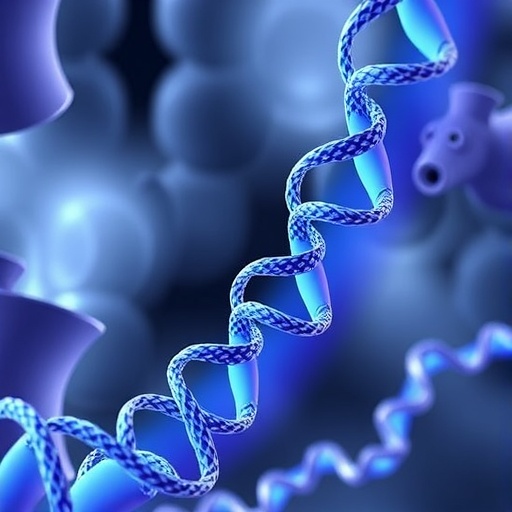In a groundbreaking study published in the Journal of Biomedical Science, researchers have unveiled critical insights into the interplay between molecular structure and antibacterial activity, focusing on the surface charge of the C-terminal helix within endolysins. This fascinating research, conducted by a team led by Kim, J. and including Son, S.M. and Ahn, E., has major implications for the development of novel antimicrobial strategies against Gram-negative bacterial infections. The significance of this work is underscored by the persistent challenge posed by antibiotic resistance and the urgent need for alternative therapeutic agents.
Endolysins, naturally occurring enzymes produced by bacteriophages, target and degrade the peptidoglycan layer of bacterial cell walls. This unique mechanism of action positions them as promising candidates for the development of new antibacterial therapies. However, the effectiveness of endolysins has been limited against Gram-negative bacteria due to their robust outer membrane, which often prevents the enzymes from reaching their target. The researchers sought to delve deeper into how the molecular characteristics of these endolysins can be enhanced to overcome such barriers.
Through advanced structural analysis techniques, the research team investigated the influence of the C-terminal helix’s surface charge on the activity of endolysins. The findings revealed that a positively charged surface is critical for effective binding to the negatively charged bacterial membranes. This charge interaction is essential for the permeation of endolysins into the bacterial cell wall, allowing these enzymes to exert their lethal effects. The study not only provides a molecular framework for understanding endolysin function but also sheds light on how modifications to the surface charge could enhance their antibacterial potency.
Examining various endolysin variants, the researchers applied mutagenesis techniques to alter the amino acid composition of the C-terminal helix. The results were striking: endolysins with optimized surface charge profiles exhibited significantly increased antibacterial activity against a range of Gram-negative bacteria, including notorious pathogens such as Escherichia coli and Klebsiella pneumoniae. These findings suggest that strategic manipulation of endolysin characteristics can pave the way for the development of tailored antibacterial agents capable of circumventing the defenses of Gram-negative pathogens.
Moreover, the study discusses the broader implications of these findings in the context of rising antibiotic resistance. As traditional antibiotics lose efficacy, alternative antimicrobial strategies become crucial. The positive surface charge enhancement can be seen as a vital step in the quest to combat multidrug-resistant bacterial infections. By creating engineered endolysins with enhanced activity, researchers hope to provide a viable solution to one of the most pressing challenges in contemporary medicine.
Additionally, the study emphasizes the need for further research into the stability and delivery mechanisms of modified endolysins. While laboratory results are promising, the translation of these findings into clinical practice necessitates thorough investigations to ensure the safety and effectiveness of these novel agents in human therapy. Understanding how these modified endolysins interact with human tissues and the host immune response is paramount.
Furthermore, the article reflects on the potential for therapeutic applications beyond the realm of antibacterial treatments. Endolysins with engineered surface properties could have implications in food safety, as they may be used to eradicate pathogenic bacteria in food processing environments. The versatility of these biomolecules extends to potential use in veterinary medicine and agricultural practices, where they could help manage bacterial infections in livestock and crops.
The researchers also highlight the collaborative nature of this study, which brought together expertise in microbiology, biochemistry, and structural biology. Such interdisciplinary approaches are increasingly recognized as essential for tackling complex biological problems, illustrating the importance of fostering collaborations among scientists from diverse fields. Sharing knowledge and tools between disciplines accelerates innovation and drives progress toward solutions for global health challenges.
As the scientific community continues to navigate the landscape of antibiotic resistance, studies like this provide hope for the future. The work by Kim et al. exemplifies a paradigm shift in how we think about bacterial infections and the potential for harnessing naturally occurring biomolecules to fight them. The intricate relationship between molecular architecture and biological function revealed in this study sets the stage for a new era of antimicrobial therapy, one that leverages nature’s ingenuity.
The implications of this research extend not just to the development of new drugs but also to the broader field of synthetic biology. By understanding the principles that govern the interaction between biomolecules and their targets, researchers can innovate new strategies to design and engineer novel biomolecules tailored for specific therapeutic purposes. This could lead to unprecedented advancements in how we approach complex diseases and infections, reshaping the future of medicine.
In conclusion, the examination of the surface charge of the C-terminal helix in endolysins opens up exciting avenues for research and application in the fight against antibiotic-resistant bacteria. The study by Kim et al. is a testament to the potential of using molecular insights to develop effective, targeted therapies that can overcome the challenges posed by Gram-negative pathogens. As the global healthcare landscape continues to evolve, innovations rooted in rigorous scientific research will be crucial in safeguarding public health against emerging threats.
In a world that increasingly relies on antibiotics, the contributions of studies like this are vital in ensuring that effective alternatives for combating bacterial infections remain within reach. The ongoing pursuit of knowledge in molecular biology, microbiology, and engineering will play an essential role in shaping the future of antimicrobial therapies, ultimately contributing to better health outcomes on a global scale.
Subject of Research: The impact of surface charge on the antibacterial activity of endolysins against Gram-negative bacteria.
Article Title: Surface charge of the C-terminal helix is crucial for antibacterial activity of endolysin against Gram-negative bacteria.
Article References:
Kim, J., Son, S.M., Ahn, E. et al. Surface charge of the C-terminal helix is crucial for antibacterial activity of endolysin against Gram-negative bacteria. J Biomed Sci 32, 38 (2025). https://doi.org/10.1186/s12929-025-01133-x
Image Credits: AI Generated
DOI: 10.1186/s12929-025-01133-x
Keywords: endolysin, antibacterial activity, Gram-negative bacteria, surface charge, antibiotic resistance, engineering, biomolecules, therapeutic applications.
Tags: antibiotic resistance alternativesbacterial cell wall targetingbacteriophage-derived enzymesC-terminal helix surface chargeendolysin antibacterial activityenzyme-target interactionGram-negative bacterial infectionsmolecular characteristics enhancementnovel antimicrobial strategiespeptidoglycan degradation mechanismsstructural analysis of endolysinstherapeutic agents against bacteria





